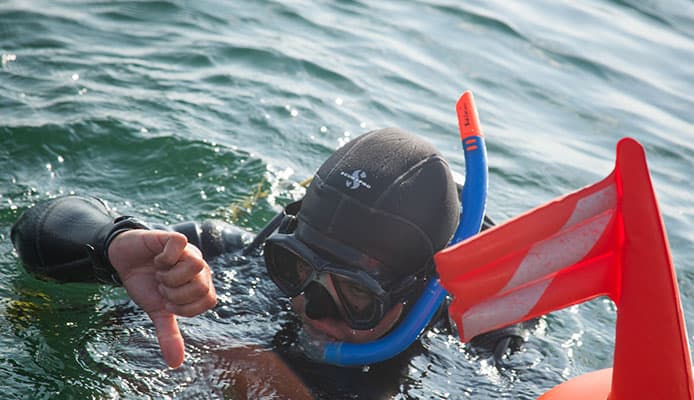
From scuba diving etiquette to know how to clear a scuba mask, there are many things that you will need to learn before your first dive. With that, in the rest of this post, our focus will be on the five-point descent.
Basically, the 5 point descent refers to the five things that you should do or check from the surface to know if you are ready for the dive. This does not only make you prepared but also reduces the likelihood that there will be unwelcomed surprises once you have already found your way under the water.
Ready to learn the five-point descent? Read on and learn from the insights we will be sharing.
The Five-Point Descent
Going on a dive is not as easy as jumping off the boat and heading straight under the water. Regardless of how excited you are, you should pay attention to the protocols. This is where the 5 point descent enters the picture.
An easy way to remember the steps involved is to know this acronym – SORTED. This stands for the five things that are briefly discussed below.
1. Signal
This is exactly what the name implies. You need to give the signal that you are ready for the descent. There is no need to use underwater signaling devices at this point as you have not yet submerged the entire body.
All that you need to do is to give the thumbs down sign. This is better than making verbal communication since it is hard for you to be heard in such an environment. To add, once you already have tor snorkels on, it will be hard to speak.
Before doing the hand signal, make sure that you and your diving buddy are both ready. No one should be still adjusting the scuba mask or the weight belts, among others.
2. Orientation
Now, you will need to orient yourself with the surrounding. In some cases, this is done by pointing to an object that can be seen from the shore. If it is too far from the shore, on the other hand, the subject of the orientation can be the direction at which the sun is.
Being familiar with the surrounding is crucial when it comes to being ready. This is especially important if you are diving into unfamiliar territory. During the orientation, you should stay as calm and composed as possible. If you are a beginner, do not panic. Otherwise, this can affect the way you move and feel throughout the entire dive.
3. Regulator
This time, you have to swap your snorkel for your scuba regulator. Some people easily get confused with the snorkel and the regulator because they almost feel the same to the mouth. However, take note of the fact that they do different things. And, when you are already deep in the water, the snorkel won’t be as effective.
When learning how to dive, one of the basic skills that you will be taught would be switching from snorkel to regulator. So, this step must be easy for you if you have already mastered that technique beforehand.
4. Time
At this point, you have to check the entry point to the descent. There are different ways to do this, depending on the gear that is present. An easy way to have it recorded is through the use of a dive watch, which has a bezel that you can set to accurately record the time.
Alternatively, you can also have it recorded on your dive computer. This is a good way to check if the computer is turned on and ready to record your dive data even after the descent.
5. Descend
For the last step, you will need to deflate your buoyancy control device or scuba BCD, and finally, descend. You need to master the right way to deflate the BCD. Do not do it too much or too little. Just do it in such a way that you will slowly sink under the water. While deflating, make sure to exhale.
You will also need to practice equalizing as you descend. This will be an essential preparation for the next equalizations that you will have to do after descending. It will also make it easier to cope with the pressure changes. When you are not able to equalize properly, some risks are possible, and one of the most common is ear barotrauma.
During the descent, it is also important to make sure that you have your inflator held firmly in your hand. This will make it quick for you to add air to your BCD, which will be necessary when you are descending. This will provide the perfect balance between buoyancy and water pressure, allowing you to adapt to the changes in the underwater environment.
You might also like: What Does SCUBA Stand For?
Globo Surfer Overview
In sum, the 5 point descent guide is an important thing to learn so that you can dive safely and comfortably, especially with a buddy. It allows you to be prepared for what will happen once you have already reached the surface. To add, this will also make it easy for you to equalize and to minimize the likelihood that the changes in pressure will affect you.
Speaking of what to do before you descend into the water, it is also important that you are familiar with the scuba diving checklist to have an assurance that you have everything that you will need.

